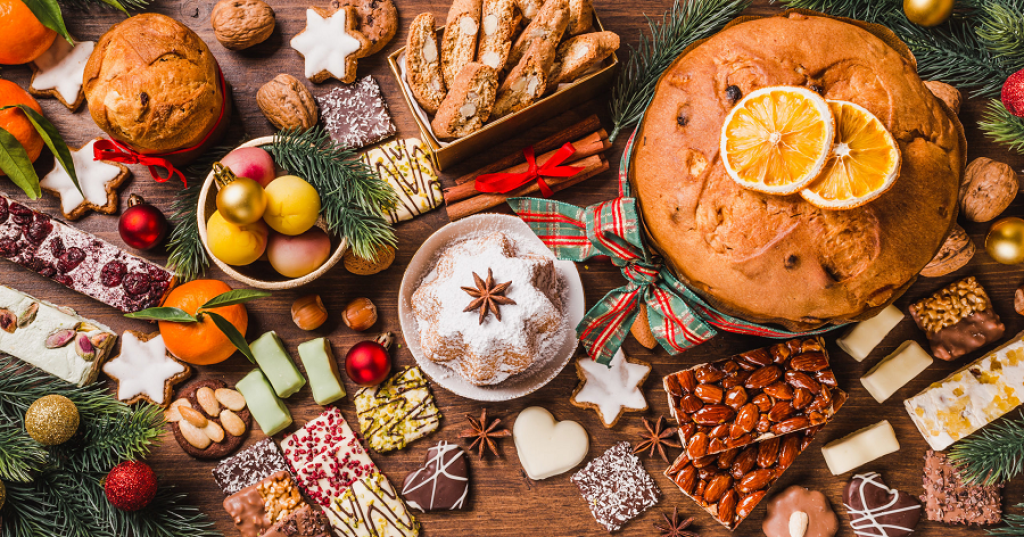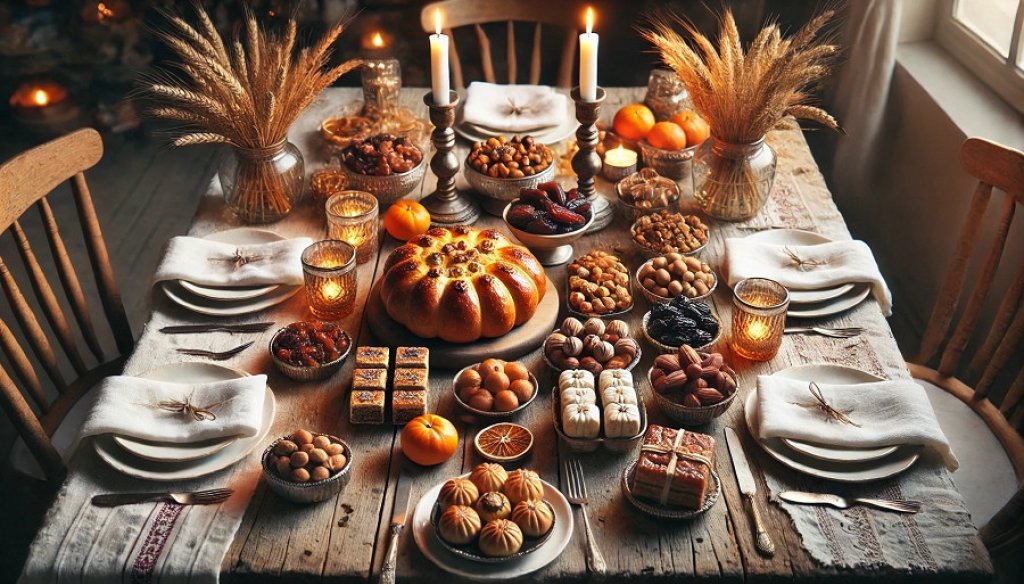The tradition of the 13 Provençal desserts: the gourmet heritage of Christmas in Provence
The thirteen desserts, or “Li trege dessèr” in Provençal, have been an emblematic Provençal Christmas tradition since the 17th century. Served after the “big supper” on December 24, these desserts symbolize Christ and his twelve apostles at the Last Supper. Presented on three white tablecloths with three candles, each guest must taste each of the thirteen sweet delicacies to ensure a prosperous year. From beggars to nougats and oil pumps, discover these delicacies that are the pride of Provencal tables.

What are the 13 Provençal Christmas desserts? The complete list
Here's the traditional list of thirteen desserts:
- The four mendicants (representing religious orders) :
Dates
Dried figs
Raisins
Walnuts
- The two nougats :
White nougat
Black nougat
- Orange blossom scentedoil pump
- Fresh fruit :
Tangerine
White grapes
Watermelon
- Local specialties :
Quince paste
Candied fruit from Apt
Of course, in some families, there are slight nuances - to each his own! Cooked wine often accompanies these sweet desserts, served after midnight mass.
What does it mean? Why thirteen desserts at Christmas?
Religious symbolism is rooted in Christ's last supper with his apostles. Each dish tells a sacred story: raisins represent the Dominican order, walnuts the Augustinian order, while black and white nougats evoke the penitents.
Dates symbolize the arrival of the Magi from the East. Oranges and mandarins, once rare and precious, embody wealth and abundance. Watermelon, preserved since autumn, recalls patience and the preservation of traditions.
Dried fruits, called pachichòis in Provençal, are a powerful symbol of the mendicant orders' vow of poverty. This accumulation of sweets remains on the table for three days, perpetuating an ancestral belief: to feed the spirits of the deceased who visit homes during the holidays.

The origins of calenos in Provence
Calenos were first written about in 1683, by Marseille priest François Marchetti. At the time, the number of calenos had not yet been determined. These sweets varied according to the resources of Provencal families.
In the early 19th century, prefect Christophe de Villeneuve-Bargemon listed these delicacies, which included cakes, dried fruit, jams and sweets. Pomp à l'huile and chestnuts had already become table staples.
The number thirteen gradually became established in the 20th century, under the influence of the félibres, the Provençal poets led by Frédéric Mistral. Their work preserved this unique gastronomic richness, passed down from generation to generation.
The Provencal Christmas platter tradition
The tray of Christmas delights is meticulously staged. Three candles glow on a table covered with three immaculate white tablecloths, creating a warm, festive atmosphere.
The sweet delicacies remain on display for three days, from December 24 to 26. The presentation follows a precise art: in the center sits the oil pump, surrounded by white and black nougats. Dried fruits are displayed in small glass or porcelain bowls.
A special place is given to fresh seasonal fruit, carefully preserved since autumn in the cellars. Citrus fruits bring their colorful notes, while watermelon, called “verdaù” in Provençal, surprises with its winter freshness.

Beggars and nougats: an essential base
The four mendiants form the base of the 13 desserts, with their complementary flavors: golden almonds, soft figs, raisins and crunchy walnuts. These dried fruits blend perfectly with the two varieties of artisanal nougat.
White nougat is distinguished by its airy texture. Made with lavender honey, almonds from Provence and sometimes pistachios, its preparation requires meticulous expertise. Its cousin, the denser black nougat, reveals caramelized notes thanks to its cooked honey and roasted dried fruit.
In some families, an ancestral recipe endures: the “nougat des capucins”, a simple fig filled with a walnut kernel. This modest version recalls the popular origins of these Mediterranean sweets.
How to present the 13 Christmas desserts?
A refined setting will sublimate your Christmas delights. Choose a large olive-wood platter or a beautiful wicker basket topped with an embroidered Provencal tablecloth. Place your arrangement in the center of the table, on three superimposed white tablecloths.
Arrange your delicacies harmoniously in colorful ceramic dishes or small glass ramekins. Fresh fruit will add a natural touch, while sweets will brighten things up with their shimmering colors.
Create a warm ambience with boughs of holly, golden pine cones and a few sprigs of dried lavender. Dimmed lighting from three orange blossom-scented candles will enhance your presentation, recalling the magical atmosphere of Provencal evenings.
The art of traditional tasting
Traditional tasting begins after midnight mass, when Provencal families gather around the table of delights. According to an ancestral rule, each guest must taste all thirteen desserts to ensure prosperity and happiness in the coming year.
The ritual begins with the oil pump, which is broken by hand, never with a knife. Dried fruits are then savored slowly, followed by nougats that melt delicately in the mouth. Citrus fruits add their freshness at the end of the tasting.
A glass of fragrant cooked wine traditionally accompanies these sweet dishes, its warm aromas sublimating the flavors of each bite. This tasting is spread over the three days of the festival, allowing you to fully appreciate each sweet treat.
Marseille specialities to savour
The navettes marseillaises stand out among local sweets with their unique shape reminiscent of the Saintes-Maries boat. The historic “Le Four des Navettes” bakery, near Abbaye Saint-Victor, has been making them since 1781, with their delicate hint of orange blossom.
Another local pastry treasure is the colombier marseillais, an almond and candied fruit cake. Its ancestral recipe is jealously guarded by a few local families.
Chichis frégis de l'Estaque bring a popular touch to the holiday table. These golden doughnuts, sprinkled with sugar, recall the moments of sharing on the Vieux-Port during winter festivities. Almond croquants from the Accoules district round off this authentic Marseille selection.
Merry Christmas to all!

